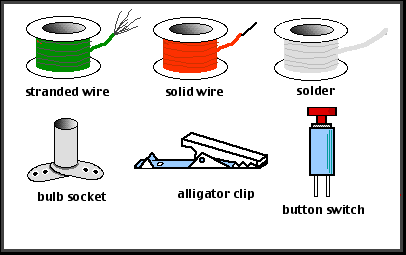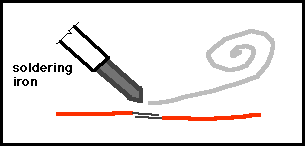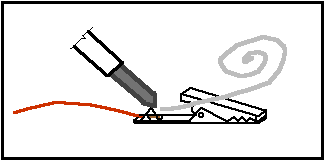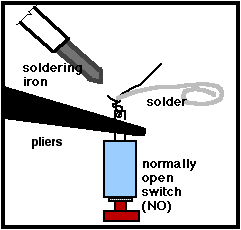 |
Hands-On-Physics
ELECTRICITY
|
Messing
Around
|
- Soldering -
|
In this activity you build a pair of clip leads that will prove to
be handy later on. To make a clip lead, you need to solder alligator
clips to both ends of a stranded, insulated wire.
Solder makes good electrical connections. It is a metal which flows into
small spaces when it is hot and makes a strong joint when cool.
Solder will not stick on dirty, wet, or oxidized surfaces. When
you plug your soldering iron in it will get hot quickly! All metal
parts of it are hot and must be treated with respect.
Before making your clip leads, practice soldering some
solid wire.

Figure M2
Materials
Practice soldering:
1. Touch the end of the solder to the soldering iron, and let the solder
flow over the tip. Wipe the excess off on a damp sponge. The tip of the
soldering iron should remain shiny. This is called tinning the soldering
iron, and it protects the tip from corroding.
2. Strip the insulation off both ends of two insulated wires, and practice
soldering them together. Heat the stripped
ends, and melt the solder onto the joint. Let it cool without disturbing
it. Then tug on it and see how strong your joint is. See the diagram below.

Figure M3
Soldering wires together
The more expert you get, the less solder you will use.
3. Try twisting the wires together before soldering them. Notice that the
solder flows into the twists easily and makes a good stron joint. However, this
type of connection is harder to heat, pull apart, and fix if you make a
mistake.
Build clip leads:
Cut about 20 cm of stranded wire, strip insulation from
the ends, and solder on alligator clips. The plastic sleeves prevent the clips
from touching other metal parts and shorting. Make two clip leads.

Figure M4
Soldering an alligator
Add leads to bulbs and switches:
When you use switches and bulbs in your circuit you'll need leads
on the terminals to connect them to your circuit board. Use solid
wire for these leads so they'll plug into the bread board.
Some components can be damaged by heat. While you are soldering,
be careful to provide a "heat sink" between the solder joint and the fragile component.
The picture below shows pliers being used as a heat sink.

Figure M5
Soldering sensitive parts
Test Your Solder Joints:
--Take your connections and clip
leads one at a time, and give them a sharp tug. If they don't break, you
can move on! If they do, fix them.
Previous Page ||
Up a Level ||
Index ||
Next Page